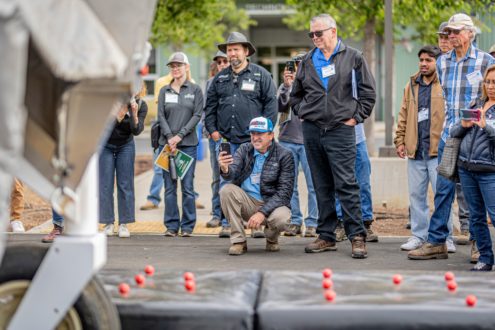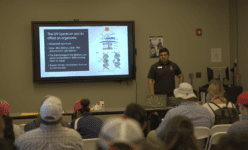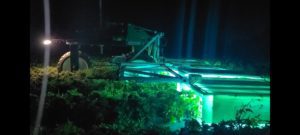

Sep 22, 2022Cal Poly strawberry research: Can robots kill pests?
The Cal Poly Strawberry Center’s Sixth Annual Field Day saw its biggest attendance yet, keeping on track with the increased participation every year since the inaugural event.
The 2022 event in late July, however, marked a return to pre-COVID norms after it was canceled in 2020 and changed to a hybrid gathering in 2021. Although organizers expected more than 300 people rotating through the automation, entomology and plant pathology stations throughout the day, more than 440 visited the Strawberry Center to learn more about the research conducted there.


“Attendance has been steadily growing each year; last year we had about 325,” said Julie Tillman, communications and accounting coordinator at the center.
Gerald Holmes, director of the Cal Poly Strawberry Center, said the research presented during the field days hasn’t been shared with growers or other industry stakeholders.
“They all come for different reasons. Some come to network, and others to get the details on the latest research,” Holmes said. “We never present something we featured last year or stuff that we’ve presented in other places. That, I think, is a big draw.”
The three main subjects – automation, entomology and pathology – each have hot topics of high interest to the industry.
“There’s always something exciting in automation,” Holmes said. “In the entomology program, we had predatory mite best practices and using UVC light for arthropod management. And on the pathology side, people want to see how the varieties are performing against the fruit rots, and we had some interesting new results looking at the color of the plastic and irrigation through drip tapes as it relates to Macrophomina fruit rots.”
Automation is here – and getting better
Several companies were on hand to showcase their robotic field equipment. Advanced Farm Technologies Inc., which recently raised $25 million from an investment round, touts itself as the first U.S. company to commercialize robotic strawberry harvesting. In 2019, the company’s harvester was used to harvest berries, and a number of companies, including Naturipe Farms, the Oppenheimer Group and GoodFarms, have used the TX Robotic Strawberry Harvester.
The harvester drew a lot of attention during the field day, as the picking arms on its underbelly hovered over the strawberry beds, jerking around as sensors targeted the next “berry” (actually, red golf balls depicted the fruit) for its grippers to pick. Visit advanced.farm/technology/strawberry-harvester/ to see a video demonstration.
“They’re out there now, harvesting,” Holmes said, as growers work with Advanced Farm Technologies on adjustments to improve performance.
“The equipment works, but it’s a question of ‘to what degree does it work?’” Holmes said. “Are they picking without injuries (to the fruit)?”
At this time, such equipment seems better suited to early in the season, before strawberry plants grow and make the red berries harder to find, Holmes said.
Shining a light on pests
Sarah Zukoff, entomology program leader at the Strawberry Center, has been working on using ultraviolet-C radiation (UVC light) to eradicate strawberry pests in the field. The UVC radiation has been used for decades to slow the spread of bacteria.


While her research falls under entomology and not automation, the equipment used to apply the light being used by growers in the area autonomously roam the fields at night. She’s working with growers who have contracted with two robotic companies, Saga Robotics and TRIC Robotics.
Some basic facts on insects and UVC:
- All organisms including insects have a natural repair mechanism that activates during daylight to repair damage done by ultra-violet light.
- A repair enzyme absorbs natural light from the sun to obtain energy for the repair processes.
- For UVC to be effective in damaging insects it must be applied only at night.
- Different stages of insects may react differently to different dosages of UVC.
- Understanding the dose of UVC required to damage different species while not disrupting the plants’ ability to thrive is critical.
Zukoff and graduate student Jose Alvarado Rojas, who presented the work at the field day, are focusing on what UVC dosage range should be used to kill two spotted spider mites, lygus bugs and spotted wing drosophila, which are common pests in California strawberry fields.
The study started in 2021 and continues to Summer 2023. Although all of the data to date hasn’t been analyzed, Zukoff said the process seems to work best with spider mites and whiteflies. The dosage needed to kill adult spotted wing drosophila and young lygus bugs, however, seems to be too high for use in strawberry crops, which can be damaged by too high of a dosage.
“I know that if you spend too much time with UVC on the plants it can be detrimental,” Zukoff said. “There’s a fine line between helping the plant and hurting the plant.”
The UVC radiation is like a sunburn, and the cumulative effect of repeated treatment kills the pests. At first, the growers were disappointed that each pass in the field didn’t leave a trail of smoking black dots.
“That’s not what happens. It’s like a sunburn that gets worse and worse as time goes by,” she said. “It’s not a bug zapper, it’s not an overnight solution. The point is to keep the insect pressure lower over time.”
One of the goals of Zukoff and others testing UVC as a pest killer is that a successful program could lower dependence on synthetic pesticides.
Although partnering with growers who are contracting with the robotic companies allows strawberry researchers to learn about what works without a large expense, it also takes away the ability of use a control group, which gives researchers another data set to work with.
“We have the UVC treatments, and then we have that compared to the growers’ standards (in the fields not treated by UVC), but we never have a full-on control group,” Zukoff said, because that would require growers to withhold treatment and lose part of their crop.
Zukoff’s group is also testing UVC light effects on the pests inside a Strawberry Center lab to back up what’s happening in fields.
The research will continue through summer 2023, and the results will be analyzed, along with information from a similar study at the University of Florida.
“Between their lab and our lab, hopefully we’ll be covering most of the pests on strawberries and there won’t be a lot of unanswered questions,” Zuckoff said. “Then it will be up to the growers.”
—Chris Koger, managing editor
Top photo: Advanced Farm’s BetterPick strawberry harvester draws a lot of attention at the Sixth Annual Cal Poly Strawberry Center Field Day. A number of growers are testing the machines in California strawberry fields. PHOTO: California Strawberry Commission
Middle photo: Jose Alvarado Rojas of the Cal Poly Strawberry Center presents information on using ultraviolet light to kill strawberry pests. PHOTO: Felipe Vallejo
Bottom photo: Researchers at the Cal Poly Strawberry Center are studying the effects of UVC light on strawberry pests. This autonomous equipment from TRIC Robotics applies the light on strawberry plants at night, and the cumulative effects of multiple doses of the light kills certain pests. Photo courtesy Cal Poly Strawberry Center.














